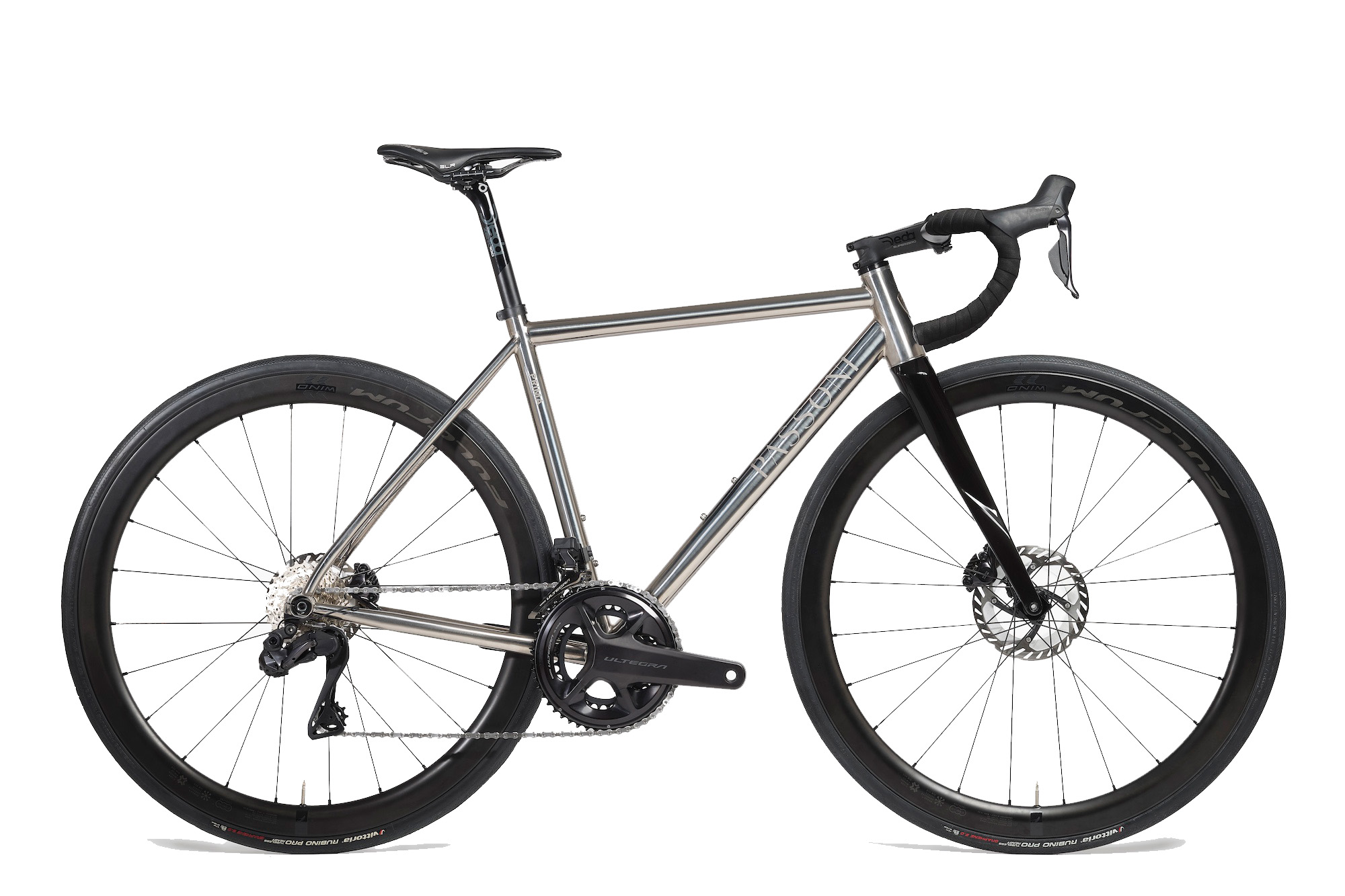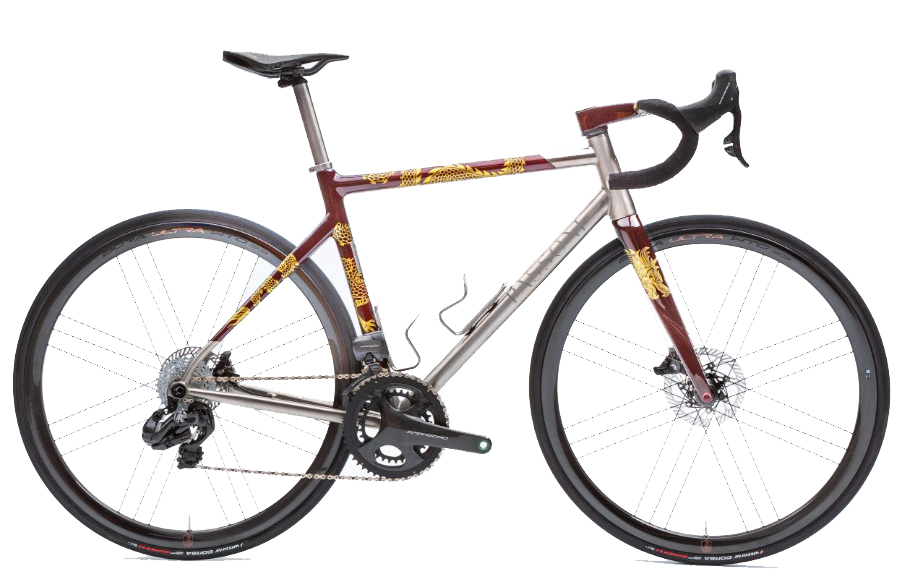Each Passoni bike results from skills and knowledge honed and passed down since the company’s founding in 1989. This means the experience of our artisans is among our greatest assets.
“I started making bicycles in 1993,” explains our lead welder Rubens from behind his bench in the Passoni workshop. The valley in which Passoni is based has long been a crucible of bicycle design and manufacture. With the advent of titanium construction, many established names in the region would approach artisan builders to recreate their frames in this new material.
“The firm where I first worked with titanium specialised in this type of third-party fabrication,” says Rubens. Having gained his initial experience with the notoriously demanding material, Rubens would go on to assist noted Italian maker Ciöcc on experimental titanium designs.
Today, Rubens is responsible for supervising the workshop and training new workers. He estimates it would take any trainee at least two years to learn the Passoni method of frame construction. In reality, as jobs are divided between stations, new employees start by repeating the most simple elements.
“The first and easiest job to learn is to cut and mitre the tubes to the correct angles and then tack weld them to the bottom bracket,” explains Rubens. Forming the heart of the bicycle, this crucial task is actually one of the simplest. This is because it comes early in the build process when access to the area is comparatively easy.
Unseen work
By comparison, it’s largely unseen elements like the continuous internal cable routing guides that are the trickiest to work on. “Because the two ends are connected to the frame, the tension must be perfect to avoid damaging the tubing as the bike moves,” he explains.
For Rubens, the greatest satisfaction comes from welds that will be left visible even when the frame is finished. These will be accomplished in Passoni’s enormous vacuum welding chamber.
Sourced from Autodelta factory near Milan, this huge bathysphere-like device allows Passoni to surround parts with inert argon gas. This is necessary because oxygen, nitrogen, hydrogen and other foreign contaminants can create defects in the weld. At the same time, operating within the confines of the vacuum chamber is a skill in itself.
“Everybody has his own method,” explains Rubens. “It’s not always easy to see another person’s way of doing things, but it will be good to have some help”.
Learning the craft
On the next stand along, and within easy reach of Rubens, is the workshop’s newest addition. Stefano has been with Passoni for less than a year. “The first thing I learned was the mechanical processes needed to finish the frame, like facing the headtube and bottom bracket,” he explains.
Stefano’s apprenticeship continued by learning to file back the welds on the frame to create the smooth finish for which Passoni bikes are famous.
Currently, Rubens is also teaching his protege to weld, with the intention that he’ll become the firm’s second welder, the first to join in over 12 years. At the same time, the additional skills needed to create a Passoni frame will be imparted by the other staff.
“Welding is the hardest part,” says Stefano. “My favourite bike to work on is the XX Ti because the cutaway seat tube makes it easier to gain access”.Among the first complete frames Stefano turns his skills to will be a custom mountain bike he’s designed for himself.
Putting it all together
A further stand along is Giovanni, who’s been with Passoni for almost three years. He’s responsible for cutting the tubes and fitting them into the jig before tacking each frame together.
“I’m responsible for everything before welding”, he explains. “Each project enters the workshop as a wooden box containing the necessary tubes and fittings, plus a printed sheet detailing the geometry”. Once the tubes leave Giovanni’s station, they’ll look exactly like a bicycle frame, with only the welding and finishing still to be completed.
“Depending on the frame, it can take eight to ten hours to cut, mitre, and tack the tubes together,” explains Giovanni. “The size of the frame can also greatly affect how difficult the process is”.
The smaller the frame, the more complex the joins between its tubes. On a large bike, there’s generally plenty of space around each. This makes it easy to assemble and weld crucial areas like the seat stays and bottom bracket. However, on smaller frames, the tubes crowd around each other. Ensuring there’s space to create strong welds on custom-made frames is a skill in itself.
“Any mitring must be done precisely because voids can undermine the strength of the weld,” says Giovanni.
Also among the most challenging elements to prepare are Passoni’s custom cast dropouts.
“Both the person doing the fitting and person welding have to achieve a lot in a very small area,” explains Giovanni.
A flawless finish
Emilio is Passoni’s longest-serving member of staff. He first began work alongside company founder Luca Passoni over 30 years ago. Incredibly experienced, he’s involved in every element of production except for welding. He’s also responsible for ensuring every frame is finished to Passoni’s famously high standards.
“After the fame is welded, I begin by checking every element is still perfectly aligned,” Emilio explains. Next, any surfaces are cleaned, and the finishing process begins in earnest.
“The first job is to file down the welds. There are no instructions for this process. It’s only experience that can teach you”.
Using a selection of rotary tools to smooth the welds and create the unique look Passoni bikes are known for, the frame is then sandblasted to create a uniform surface.
“The polishing is then done by hand,” explains Emilio. In total, finishing can take as many as 30 hours.
The tools used in this process are also increasingly rare, meaning one of Emilio’s crucial jobs is maintaining those that Passoni currently possesses. “Every 30 frames, we must recondition the tools,” he explains.
Like a sculptor, Emilio has favourite tools for achieving his desired effects. He describes one particular design as essential for creating the Passoni look.
“It’s a very odd shape. It’s very thick, but you can use it in many different ways”, says Emilio. “Our frames are very curved and harmonious, and without this tool, you can’t have the Passoni look”.
While his work ensures that every frame leaves Passoni with a uniform finish to the trained eye, each artisan’s work is instantly recognisable.
“Outside the workshop, no one can tell the difference,” he says. “But everyone here can look and see from the frame who did each job”.

 Ready-to-ride
Ready-to-ride Made-to-measure
Made-to-measure Special edition
Special edition